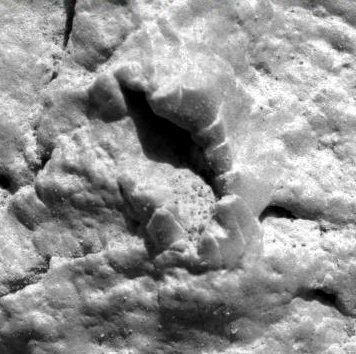

Occasionally, the Dry Dredgers are asked to respond to the assertion that a photo taken by NASA's Mars Exploration Rover, Opportunity, is of a crinoid fossil. This is largely due to a web site that references the Cincinnatian crinoid photos on drydredgers.org.
Alas, I can be fairly certain that the image in the photo is not crinoidal. For 100% certainty I would need to have it in my hand which isn't very likely.

Here are a few reasons why I am most certain this is not a crinoid.
The raised part of the image that looks crinoidal blends into the matrix as if it is part of the matrix itself. If this were a real fossil there would have been some line of demarcation between the fossil and the matrix.
As much as we would like to do so, it is really not possible to positively identify fossils from photographs. Images can look different with variation in lighting and resolution. Photographs are used in professional journals as illustrations accompanying lengthy technical descriptions by the authors who examined the actual specimens. Papers such as this have to use a suite of photographs to illustrate various points in the word description. The Mars photo is illustrative but not diagnostic.
Even here in our local area many specimens are collected that "look like" something else. Sedimentary structures and broken pieces of larger fossils often look very much like other legitimate fossils. It takes a certain amount of experience to determine the difference. Even when explaining that to a collector, the collector oftentimes will still maintain that we are wrong and they have collected some rare never before seen specimen.
The conclusion that a specimen on Earth represents a once living animal is made in the context of a large body of information. That information includes knowledge of the stratigraphic layers surrounding the specimen, the conclusions from related fossil discoveries, and the analogies of descended, living specimens, to mention just a few.
The real science happening on Mars has found mineralogic evidence that supports the theory that life may have once flourished there. The inference is made because the minerals found appear in a sedimentological setting and here on Earth in that same setting they would have been produced as a result of life processes. The life that is being inferred here is bacterial not multicellular life.
The last thing I will add is that people see what they want to see. Many studies have been done trying to figure out why this is so. These beliefs range from UFOs, bigfoot, Nessie, images of religious figures on burnt toast or mineral stains on highway overpasses. If you have an interest in reading about such things I can recommend that you seek out the magazine Skeptical Enquirer.
Back to Identifying Cincinnati Crinoids
Return to Dry Dredgers Home Page
The Dry Dredgers and individual contributors reserve the
rights to all information, images, and content presented here. Permission to
reproduce in any fashion, must be requested in writing to
admin@drydredgers.org
.
www.drydredgers.org is designed and maintained by Bill
Heimbrock.